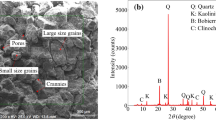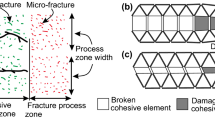Abstract
We investigate herein the scale effect and anisotropy of jointed rock mass (JRM) from the perspective of acoustic emission (AE) characteristics and estimate the size of the representative element volume (REV). First, we propose an AE calculation based on the discrete element method (DEM) and use the statistical results of joint planes to generate a discrete fracture network. Next, we calibrate the micro-parameters of the rock matrix and the joint plane based on physical experiment and the single plane of weakness theory, respectively. Finally, we use the proposed model to numerically simulate the AE characteristics of a JRM and estimate the size of the REV. The use of different model sizes and layer orientations shows that the AE event magnitude follows a power-law distribution. The frequency of AE events with different magnitudes follows a normal distribution, and a negative exponential relationship is found between the frequency of AE events and the number of cracks associated with each AE event. When the model size exceeds 10 × 10 m, the parameters of AE events (accumulated frequency, magnitude, frequency of AE events associated with only one crack, frequency of AE events associated with over ten cracks, and maximum crack number associated with each AE event) remain essentially constant. This means that the size of the REV is 10 × 10 m. The proposed model should also prove useful for further research into the fracture mechanism of JRM.










Similar content being viewed by others
References
Andrä H, Combaret N, Dvorkin J, Glatt E, Han J, Kabel M, Keehm Y, Krzikalla F, Lee M, Madonna C, Marsh M, Mukerji T, Saenger EH, Sain R, Saxena N, Ricker S, Wiegmann A, Zhan X (2013) Digital rock physics benchmarks—part i: imaging and segmentation. Comput Geosci-Uk 50:25–32
Bahaaddini M, Sharrock G, Hebblewhite BK (2013) Numerical investigation of the effect of joint geometrical parameters on the mechanical properties of a non-persistent jointed rock mass under uniaxial compression. Comput Geotech 49:206–225
Blum P, Mackay R, Riley MS, Knight JL (2007) Hydraulische modellierung und die ermittlung des repräsentativen elementarvolumens (rev) im kluftgestein. Grundwasser 12:48–65
Cai M, Kaiser PK, Morioka H, Minami M, Maejima T, Tasaka Y, Kurose H (2007) Flac/pfc coupled numerical simulation of AE in large-scale underground excavations. Int J Rock Mech Min 44(4):550–564
Chen W, Konietzky H (2014) Simulation of heterogeneity, creep, damage and lifetime for loaded brittle rocks. Tectonophysics 633:164–175
Cho N, Martin CD, Sego DC (2007) A clumped particle model for rock. Int J Rock Mech Min 44(7):997–1010
Chong Z, Li X, Hou P, Wu Y, Zhang J, Chen T, Liang S (2017) Numerical investigation of bedding plane parameters of transversely isotropic shale. Rock Mech Rock Eng 20(5):1183–1204
Ding X, Zhang L, Zhu H, Zhang Q (2014) Effect of model scale and particle size distribution on pfc3d simulation results. Rock Mech Rock Eng 47(6):2139–2156
Esmaieli K, Hadjigeorgiou J, Grenon M (2010) Estimating geometrical and mechanical rev based on synthetic rock mass models at Brunswick Mine. Int J Rock Mech Min 47(6):915–926
Fan X, Kulatilake PHSW, Chen X (2015) Mechanical behavior of rock-like jointed blocks with multi-non-persistent joints under uniaxial loading: a particle mechanics approach. Eng Geol 190:17–32
Gao F, Stead D, Kang H (2014) Numerical investigation of the scale effect and anisotropy in the strength and deformability of coal. Int J Coal Geol 136:25–37
Hazzard JF, Young, RP (2000) Simulating acoustic emissions in bonded-particle models of rock. 37(5): 867–872
Heinze T, Galvan B, Miller SA (2015) A new method to estimate location and slip of simulated rock failure events. Tectonophysics 651-652:35–43
Hoek E, Kaiser PK, Bawden WF (1995) Support of underground excavations in hard rock. A. A. Balkema Publishers
Hou P, Gao F, Yang Y, Zhang X, Zhang Z (2016) Effect of the layer orientation on mechanics and energy evolution characteristics of shales under uniaxial loading. Int J Min Sci Technol 26(5):857–862
Huang Y, Yang S, Tian W, Zeng W, Yu L (2016) An experimental study on fracture mechanical behavior of rock-like materials containing two unparallel fissures under uniaxial compression. Acta Mech Sinica-Prc 32(3):442–455
Ivars DM, Pierce ME, Darcel C, Reyes-Montes J, Potyondy DO, Young RP, Cundall PA (2011) The synthetic rock mass approach for jointed rock mass modelling. Int J Rock Mech Min 48(2):219–244
Jaeger JC (1960a) Shear failure of anistropic rocks. Geol Mag 97(01):65
Jaeger JC (1960b) Shear strength of weakness planes in rock. Geol Mag 91(01):65–72
Karacan CÖ (2009) Forecasting gob gas venthole production performances using intelligent computing methods for optimum methane control in longwall coal mines. Int J Coal Geol 79(4):131–144
Karakul H, Ulusay R (2013) Empirical correlations for predicting strength properties of rocks from p-wave velocity under different degrees of saturation. Rock Mech Rock Eng 46(5):981–999
Kovari K, Tisa A, Einstein HH, Franklin JA (1983) Suggested methods for determining the strength of rock materials in triaxial compression: revised version. Int J Rock Mech Min 20(6):283–290
Kulatilake PHSW (1985) Estimating elastic constants and strength of discontinuous rock. J Geotech Eng 111(7):847–864
Kulatilake PHSW, Wang S, Stephansson O (1993a) Effect of finite size joints on the deformability of jointed rock in three dimensions. Int J Rock Mech Min 30(5):479–501
Kulatilake PHSW, Wathugala D, Stephansson O (1993b) Joint network modelling with a validation exercise in Stripa Mine, Sweden. Int J Rock Mech Min 30(5):503–526
Kulatilake PHSW, Chen J, Teng J, Shufang X, Pan G (1996) Discontinuity geometry characterization in a tunnel close to the proposed permanent shiplock area of the three gorges dam site in China. Int Int J Rock Mech Min 33(3):255–277
Kulatilake PHSW, Malama B, Wang J (2001) Physical and particle flow modeling of jointed rock block behavior under uniaxial loading. Int J Rock Mech Min 38(5):641–657
Kulatilake PHSW, Um J, Wang M, Escandon R, Narvaiz J (2003) Stochastic fracture geometry modeling in 3-D including validations for a part of Arrowhead East Tunnel, California, USA. Eng Geol 70(1):131–155
Lisjak A, Liu Q, Zhao Q, Mahabadi OK, Grasselli G (2013) Numerical simulation of acoustic emission in brittle rocks by two-dimensional finite-discrete element analysis. Geophys J Int 195(1):423–443
Liu J, Li Y, Xu S, Xu S, Jin C, Liu Z (2015) Moment tensor analysis of acoustic emission for cracking mechanisms in rock with a pre-cut circular hole under uniaxial compression. Eng Fract Mech 135:206–218
Mahdevari S, Maarefvand P (2016) An investigation into the effects of block size distribution function on the strength of bimrocks based on large-scale laboratory tests. Arab J Geosci 9(7)
Mclamore R, Gray KE (1967) The mechanical behavior of anisotropic sedimentary rocks. J Eng Ind:62–73
Mehranpour MH, Kulatilake PHSW (2016) Comparison of six major intact rock failure criteria using a particle flow approach under true-triaxial stress condition. Geomech Geophys Geo-Energy Geo-Resour 2(4):203–229
Mehranpour MH, Kulatilake PHSW (2017) Improvements for the smooth joint contact model of the particle flow code and its applications. Comput Geotech 87:163–177
Mehranpour MH, Kulatilake PHSW, Ma X, He M (2018) Development of new three-dimensional rock mass strength criteria. Rock Mech Rock Eng 51(11):3537–3561
Min K, Jing L, Stephansson O (2004) Determining the equivalent permeability tensor for fractured rock masses using a stochastic rev approach: method and application to the field data from Sellafield, UK. Hydrogeol J 12(5):497–510
Moriya H, Naoi M, Nakatani M, Aswegen GV, Murakami O, Kgarume T, Ward AK, Durrheim RJ, Philipp J, Yabe Y, Kawakata H, Ogasawara H (2015) Delineation of large localized damage structures forming ahead of an active mining front by using advanced acoustic emission mapping techniques. Int J Rock Mech Min 79:157–165
Pierce M, Cundall R, Potyondy D, Ivars DM (2007) A synthetic rock mass model for jointed rock. In: Eberhardt E, Stead D, Morrison T (eds) Proceedings and Monographs in Engineering, Water and Earth Sciences, pp 341–349
Potyondy DO, Cundall PA (2004) A bonded-particle model for rock. Int J Rock Mech Min 41(8):1329–1364
Shi X, Cai W, Meng Y, Li G, Wen K, Zhang Y (2016) Weakening laws of rock uniaxial compressive strength with consideration of water content and rock porosity. Arab J Geosci 9(5)
Shivakumar K, Rao MVMS (2000) Application of fractals to the study of rock fracture and rockburst-associated seismicity. New Delhi. Application of Fractals in Earth Sciences. AA Balkema, USA/Oxford, and IBH Pub. Co., pp 171–188
Shukla R, Ranjith PG, Choi SK, Haque A, Yellishetty M, Hong L (2013) Mechanical behaviour of reservoir rock under brine saturation. Rock Mech Rock Eng 46(1):83–93
Tang CA, Liu H, Lee P, Tsui Y, Tham LG (2000a) Numerical studies of the influence of microstructure on rock failure in uniaxial compression-part i: effect of heterogeneity. Int J Rock Mech Min 37(4):555–569
Tang CA, Tham LG, Lee P, Tsui Y, Liu H (2000b) Numerical studies of the influence of microstructure on rock failure in uniaxial compression-part ii: constraint, slenderness and size effect. Int J Rock Mech Min 37(4):571–583
Vásárhelyi B, Kovács D (2017) Empirical methods of calculating the mechanical parameters of the rock mass. Period Polytech-Civ 61(1):39
Wang P, Yang T, Xu T, Cai M, Li C (2016) Numerical analysis on scale effect of elasticity, strength and failure patterns of jointed rock masses. Geosci J 20(4):539–549
Wu Q, Kulatilake PHSW (2012) Application of equivalent continuum and discontinuum stress analyses in three-dimensions to investigate stability of a rock tunnel in a dam site in China. Comput Geotech 46:48–68
Wu S, Xu X (2016) A study of three intrinsic problems of the classic discrete element method using flat-joint model. Rock Mech Rock Eng 49(5):1813–1830
Xue L, Qin S, Sun Q, Wang Y, Lee LM, Li W (2014) A study on crack damage stress thresholds of different rock types based on uniaxial compression tests. Rock Mech Rock Eng 47(4):1183–1195
Yang XX, Qiao WG (2018) Numerical investigation of the shear behavior of granite materials containing discontinuous joints by utilizing the flat-joint model. Comput Geotech 104(12):69–80
Younessi A, Rasouli V (2010) A fracture sliding potential index for wellbore stability analysis. Int J Rock Mech Min 47(6):927–939
Zhang L (2010) Estimating the strength of jointed rock masses. Rock Mech Rock Eng 43(4):391–402
Zhao XG, Wang J, Cai M, Cheng C, Ma LK, Su R, Zhao F, Li DJ (2014) Influence of unloading rate on the strainburst characteristics of Beishan granite under true-triaxial unloading conditions. Rock Mech Rock Eng 47(2):467–483
Zhao Q, Tisato N, Grasselli G, Mahabadi OK, Lisjak A, Liu Q (2015) Influence of in-situ stress variations on acoustic emissions: a numerical study. Geophys J Int 203(2):1246–1252
Funding
This research is supported by the Fundamental Research Funds for the Central Universities (2017XKZD06).
Author information
Authors and Affiliations
Corresponding author
Additional information
Responsible Editor: Zeynal Abiddin Erguler
Rights and permissions
About this article
Cite this article
Chong, Z., Yao, Q., Li, X. et al. Acoustic emission investigation on scale effect and anisotropy of jointed rock mass by the discrete element method. Arab J Geosci 13, 324 (2020). https://doi.org/10.1007/s12517-020-05303-z
Received:
Accepted:
Published:
DOI: https://doi.org/10.1007/s12517-020-05303-z




